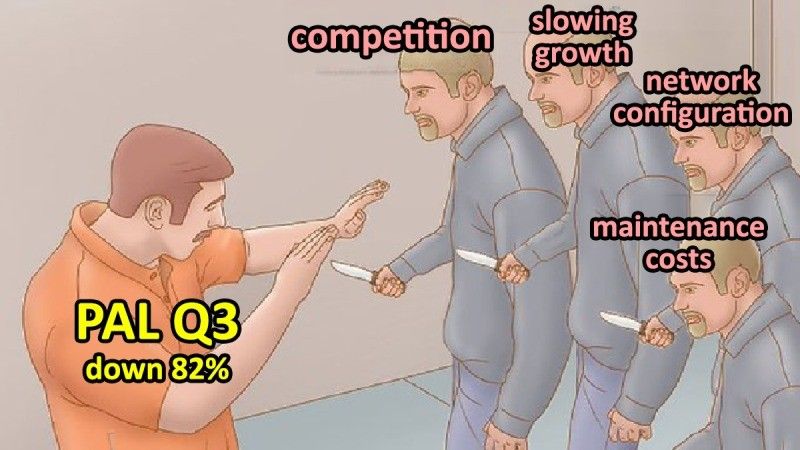Philippine Airlines Q3 profit: P789M (down 82% y/y)

Philippine Airlines [PAL 5.24, down 1.1%; 673% avgVol] [link] posted a Q3 net income of P789 million, down 82% y/y from its Q3/23 net income of P4,278 million, and down 70% q/q from its Q2/24 net income of P2,590 million. On a 9M basis, PAL’s net income was down 58% to P8,075 million. PAL declined to comment specifically on its Q3 results, but in a press release contextualized the huge drop in 9M profitability on a 3.68% drop in passenger revenues to P115.66 billion (down from P120.08 billion). PAL said that its passenger volume increased by 6.4% to 11.71 million passengers, but that its “yield per passenger” dropped by 6.9% (not nice) “due to increased competition in the market.” The Tan Family’s airline noted higher cargo and ancillary revenues, but also higher consolidated operating expenses, which increased 9.5% to P109.7 billion. PAL attributed this increase to an uptick in round-trip flights, and maintenance expenses, which increased 12% to P17.5 billion. PAL President and COO, Stanley Ng, is quoted in the press release as saying, “We are continuing to see a moderation in growth and a more challenging business environment where rising costs exert greater pressure on the economics of airline operations.”
MB BOTTOM-LINE: For those who were around the PSEi trading in the 2010s and who personally witnessed PAL’s bankruptcy and emergence from that process in early 2022, the story of how this airline survived is something that sticks with you. But as entertaining as the story of an old man incinerating his billions can be, what really matters to the public float is how the stock has performed since PAL’s rise from the ashes. That’s where the bad news starts. Well, actually the bad news starts with the company’s name (which contains the word “airlines”), but that’s a story for a different post. PAL re-debuted on the PSEi trading at around P6.50/share, then dropped to a P5.50 to P6.00/share range in mid-2022, and then dropped to a P5.00 to P5.50/share range in mid-2023. We’re kind of on the ugly side of that range now, with PAL having spent a number of months this year hovering gently over the P5.00 level. I’ve had some people ask me if PAL (or its main rival, Cebu Pacific [CEB 31.30, down 1.7%; 135% avgVol]) form part of my middle-class thesis, and while that could have been the case with CEB back before the pandemic when planes, parts, and passengers were all plentiful and available, COVID and everything that has happened after it has shown me in clear terms that airlines are too risky for my blood. They’re so exposed. Fuel risk. Foreign exchange risk. Climate risk. Travel restriction risk. Procurement risk. Political risk. It’s just such a mess. As evidenced here by this dramatic downtick in profitability from just a small dip in passenger volume.

Merkado Barkada is a free daily newsletter on the PSE, investing and business in the Philippines. You can subscribe to the newsletter or follow on Twitter to receive the full daily updates.
- Latest






















